外语教学心理学第七讲-Task
- 格式:ppt
- 大小:283.50 KB
- 文档页数:28
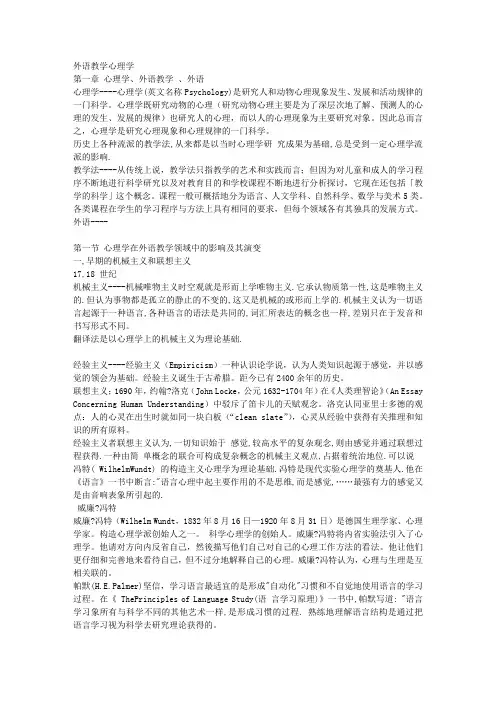
外语教学心理学第一章心理学、外语教学、外语心理学----心理学(英文名称Psychology)是研究人和动物心理现象发生、发展和活动规律的一门科学。
心理学既研究动物的心理(研究动物心理主要是为了深层次地了解、预测人的心理的发生、发展的规律)也研究人的心理,而以人的心理现象为主要研究对象。
因此总而言之,心理学是研究心理现象和心理规律的一门科学。
历史上各种流派的教学法,从来都是以当时心理学研究成果为基础,总是受到一定心理学流派的影响.教学法----从传统上说,教学法只指教学的艺术和实践而言;但因为对儿童和成人的学习程序不断地进行科学研究以及对教育目的和学校课程不断地进行分析探讨,它现在还包括「教学的科学」这个概念。
课程一般可概括地分为语言、人文学科、自然科学、数学与美术5类。
各类课程在学生的学习程序与方法上具有相同的要求,但每个领域各有其独具的发展方式。
外语----第一节心理学在外语教学领域中的影响及其演变一,早期的机械主义和联想主义17,18 世纪机械主义----机械唯物主义时空观就是形而上学唯物主义.它承认物质第一性,这是唯物主义的.但认为事物都是孤立的静止的不变的,这又是机械的或形而上学的.机械主义认为一切语言起源于一种语言,各种语言的语法是共同的,词汇所表达的概念也一样,差别只在于发音和书写形式不同。
翻译法是以心理学上的机械主义为理论基础.经验主义----经验主义(Empiricism)一种认识论学说,认为人类知识起源于感觉,并以感觉的领会为基础。
经验主义诞生于古希腊。
距今已有2400余年的历史。
联想主义;1690年,约翰?洛克(John Locke,公元1632-1704年)在《人类理智论》(An Essay Concerning Human Understanding)中驳斥了笛卡儿的天赋观念。
洛克认同亚里士多德的观点:人的心灵在出生时就如同一块白板(“clean slate”),心灵从经验中获得有关推理和知识的所有原料。
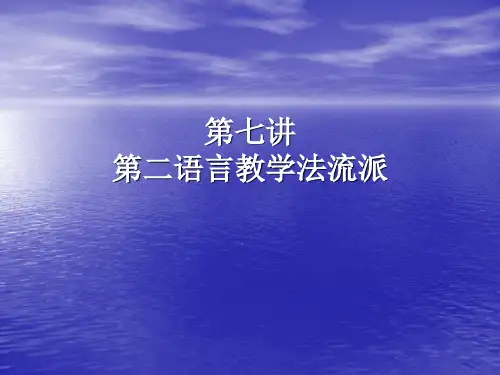
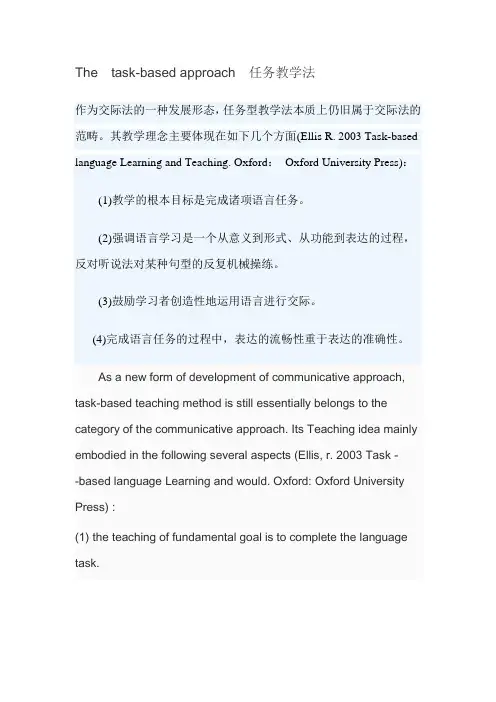
The task-based approach 任务教学法作为交际法的一种发展形态,任务型教学法本质上仍旧属于交际法的范畴。
其教学理念主要体现在如下几个方面(Ellis R. 2003 Task-based language Learning and Teaching. Oxford:Oxford University Press):(1)教学的根本目标是完成诸项语言任务。
(2)强调语言学习是一个从意义到形式、从功能到表达的过程,反对听说法对某种句型的反复机械操练。
(3)鼓励学习者创造性地运用语言进行交际。
(4)完成语言任务的过程中,表达的流畅性重于表达的准确性。
As a new form of development of communicative approach, task-based teaching method is still essentially belongs to the category of the communicative approach. Its Teaching idea mainly embodied in the following several aspects (Ellis, r. 2003 Task --based language Learning and would. Oxford: Oxford University Press) :(1) the teaching of fundamental goal is to complete the language task.(2) the emphasis on language learning is a from meaning to form, from the function to express the process, method of opposition to hear some sentence patterns of repeated mechanical drill.(3) encourage learners to communicate creatively use the language.(4) to complete the task of language in the process, the accuracy of the expression of fluency is more important than.任务型教学法具有如下几个鲜明的特质:(一)任务型课堂教学中的任务是一种现实性的交际活动。
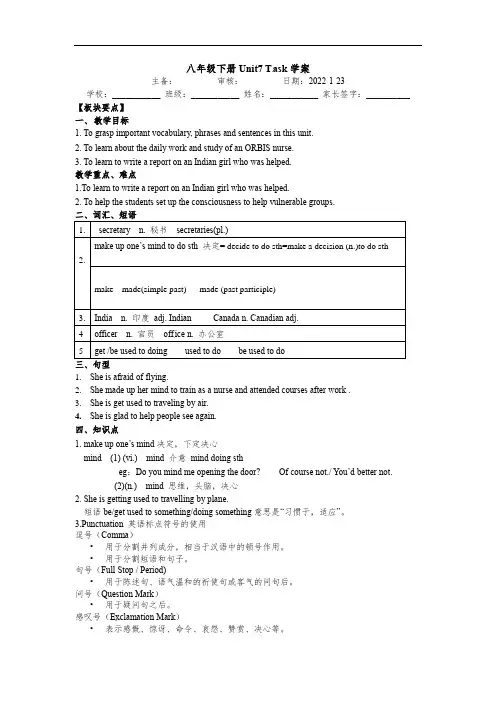
八年级下册Unit7 Task学案主备:审核:日期:2022-1-23学校:___________ 班级:___________ 姓名:___________ 家长签字:__________【板块要点】一、教学目标1. To grasp important vocabulary, phrases and sentences in this unit.2. To learn about the daily work and study of an ORBIS nurse.3. To learn to write a report on an Indian girl who was helped.教学重点、难点1.To learn to write a report on an Indian girl who was helped.2. To help the students set up the consciousness to help vulnerable groups.二、词汇、短语1. secretary n. 秘书secretaries(pl.)make up one’s mind to do sth 决定= decide to do sth=make a decision (n.)to do sth2.make made(simple past) made (past participle)3. India n. 印度adj. Indian Canada n. Canadian adj.4 officer n. 官员off ice n. 办公室5 get /be used to doing used to do be used to do三、句型1.She is afraid of flying.2.She made up her mind to train as a nurse and attended courses after work .3.She is get used to traveling by air.4.She is glad to help people see again.四、知识点1. make up one’s mind决定,下定决心mind (1) (vi.) mind 介意mind doing stheg:Do you mind me opening the door? ----- Of course not./ You’d better not.(2)(n.) mind 思维,头脑,决心2. She is getting used to travelling by plane.短语be/get used to something/doing something意思是“习惯于,适应”。
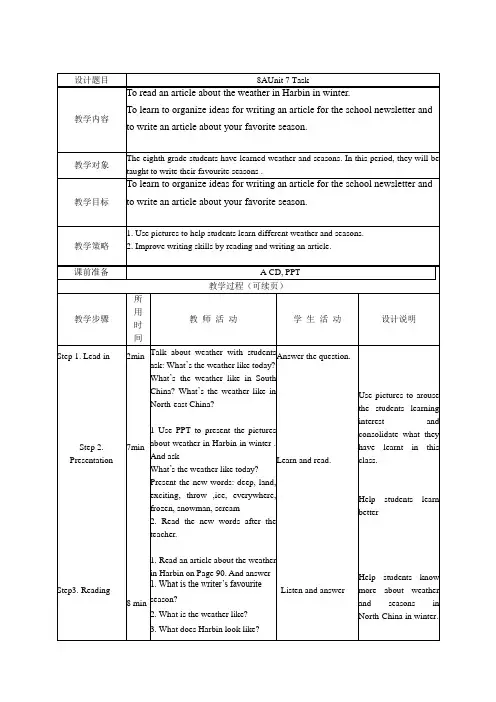

《牛津高中英语》TASK的教学困惑及应对策略一、问题的提出《普通高中英语课程标准》(实验)特别指出:“高中英语课程应根据高中学生认知特点和学习发展需要,在进一步发展学生基本语言运用能力的同时,着重提高学生用英语获取信息、处理信息、分析和解决问题的能力;逐步培养学生用英语进行思维和表达的能力。
”引导高中英语课程更注重培养学生学英语和用英语的能力,学用结合,促进积极思维和有效表达,体现素质教育精神和人文思想。
特别是在课程目标中,把提高人的综合素质作为提高语言综合能力的前提,真正达到通过英语课程促进学生全面发展的目的。
高中英语课程的设计与实施,要有利于学生改变传统的被动记忆、机械训练的学习方式,采用积极主动的参与式和合作式的英语学习方式,使他们通过接触与社会、科技及他们生活密切相关的、比较真实和自然的语言材料,通过观察、体验、探究等积极主动的学习方法,挖掘学习潜能,形成有效的学习策略,提高自主学习能力。
根据这一新课标要求,新教材的编写遵循了五条基本原则:时代性原则、基础性与选择性相结合的原则、发展性和拓展性原则、科学性原则、思想性原则,体现了“做中学英语(do tolearn)”的教学思想。
以话题为主线、活动为形式,将话题、功能、任务、结构有机地结合起来,组织和安排听、说、读、写的活动,引导学生积极尝试,主动实践,进行探究性学习。
《牛津高中英语》的TASK板块是一个要求学生在课堂内进行的开放型任务型活动的教学内容。
该板块以单元话题为主线,让学生在教学活动中用英语参与和完成各种真实而有意义的与生活、学习、工作有关的活动。
学生可以通过结对、小组合作或是班级内合作的方式,亲历语言实践,实现任务目标。
但是在教学实际中,面对新教材,面对新课程背景下的学生,教师产生了一些新困惑。
二、TASK板块分析1.结构该板块含有三个步骤(steps),给学生提供了真实的情景,并设计了目标明确的活动。
步骤1:侧重培养学生获取信息的能力(receptive);步骤2:侧重鼓励学生学会合作,发展与他人沟通的能力,实现教师和学生、学生与学生之间的互动(interactive);步骤3:侧重完成一个富有情景的写作任务(productive)。
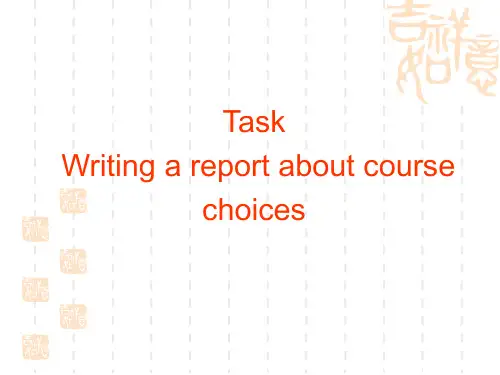
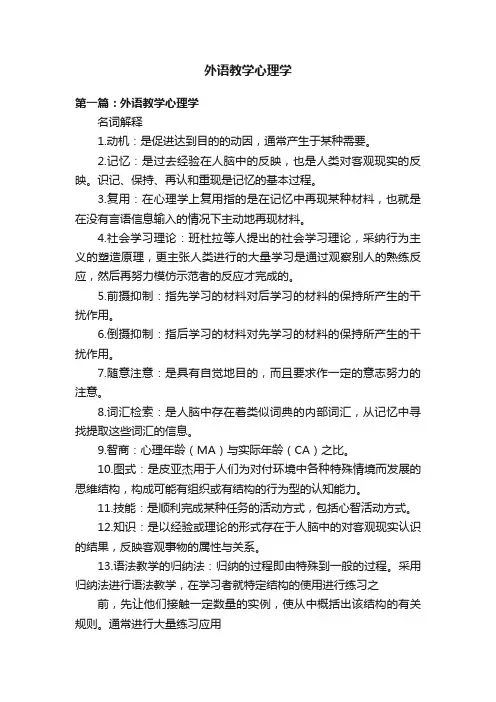
外语教学心理学第一篇:外语教学心理学名词解释1.动机:是促进达到目的的动因,通常产生于某种需要。
2.记忆:是过去经验在人脑中的反映,也是人类对客观现实的反映。
识记、保持、再认和重现是记忆的基本过程。
3.复用:在心理学上复用指的是在记忆中再现某种材料,也就是在没有言语信息输入的情况下主动地再现材料。
4.社会学习理论:班杜拉等人提出的社会学习理论,采纳行为主义的塑造原理,更主张人类进行的大量学习是通过观察别人的熟练反应,然后再努力模仿示范者的反应才完成的。
5.前摄抑制:指先学习的材料对后学习的材料的保持所产生的干扰作用。
6.倒摄抑制:指后学习的材料对先学习的材料的保持所产生的干扰作用。
7.随意注意:是具有自觉地目的,而且要求作一定的意志努力的注意。
8.词汇检索:是人脑中存在着类似词典的内部词汇,从记忆中寻找提取这些词汇的信息。
9.智商:心理年龄(MA)与实际年龄(CA)之比。
10.图式:是皮亚杰用于人们为对付环境中各种特殊情境而发展的思维结构,构成可能有组织或有结构的行为型的认知能力。
11.技能:是顺利完成某种任务的活动方式,包括心智活动方式。
12.知识:是以经验或理论的形式存在于人脑中的对客观现实认识的结果,反映客观事物的属性与关系。
13.语法教学的归纳法:归纳的过程即由特殊到一般的过程。
采用归纳法进行语法教学,在学习者就特定结构的使用进行练习之前,先让他们接触一定数量的实例,使从中概括出该结构的有关规则。
通常进行大量练习应用所学语法规则。
14.感觉记忆:指感知停止后瞬间即逝的记忆,是将进入的感觉信息保持到某类型被认知的系统。
15.语感:在心理学上应属于被称为理智感的情感范畴。
应理解为对语言的感性反映。
语言联系和关系的所有这些感性反映形式构成巨大而复杂的感性复合体,这便是语感。
16.气质:是个性心理的重要特征之一,表现于心理过程的速度和稳定性、心理过程的强度,以及心理活动的指向性特点(外倾或内倾)。
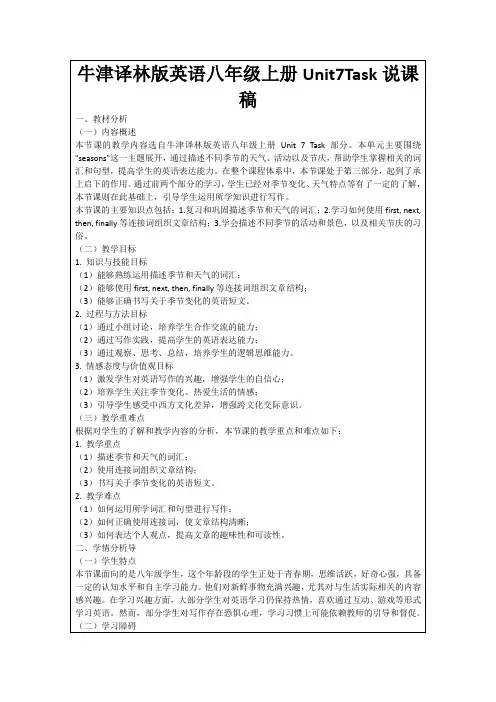

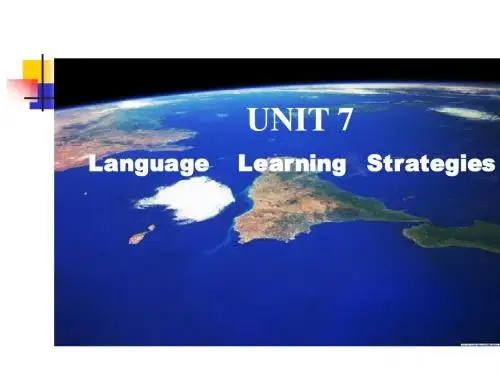
The Task-based Instruction1. Definition of a task(1) A task is a piece of work undertaken for oneself or for others, freely or for some reward. Task is meant the hundred and one things people do in everyday life, at work, at play and in between—Long (1985:89)(2)Task is assumed to refer to a range of workplans. It has a particular objective, appropriate content, a specified working procedure, and arrange of outcomes for those who undertake the task. It has the overall purpose of facilitating language learning.--Breen (1987:23)(3) A task is an activity which requires learners to arrive at an outcome from given information through some process of thought and which allows teachers to control and regulate that process--Prabhu(1987:24)(4) A piece of classroom work, which involves learners in comprehending, manipulating (make good use of) producing or interacting in the target language while their attention is principally focused on meaning rather than form.--Nunan (1989:8)(5) Tasks are activities where the target language is used by the learner for a communicative purpose in order to achieve an outcome.--Willis (1996:23)Summary about a definition of a taskTask means the hundred and one things people do in a real life. It has a particular objective, appropriate content, a specified working procedures/process; based on a range of outcomes the learners undertake the task. It focused on meaning rather than form in a real context through comprehending, manipulating, producing, interacting, the process of thoughts in pairs or groups. The product can be observable in the oral way or written form.3. Four components of a taskA purposeA context•A process:•A product:•E.g., Going shopping•Look at Mary’s shopping list. Then look at Susan’s list of items in Susan’s store.(1) Mary’s shopping list:Orange, eggs, flour, powdered milk (奶粉)biscuits, jam.(2) Susan’s store:bread, salt, apples, Coca Cola, tins of fish, flour, chocolate, sugar, biscuits, powdered milk, dried beans.( requirements) Work with a partner one person be Mary and the other be Susan. Make a conversation like this:•Mary: Good morning, do you have any flour?•Susan: Yes, I do.•Or•Mary: Good morning, do you have any jam?•Susan: No, I am sorry. I do not have any.real-life tasks•Purpose: used to communicate, message delivering and problem-solving•Content for activity is a kind of contextualized, whole and authentic language materials •Teaching principles for implementation based on task.1. Meaning and form 形式与意义结合2. Recycling (在某时间段内或材料内,不断复现知识)循环性原则3. Learning by doing (active learning, accommodation some experience, individual learning, reproduction 模仿to creation)做中学原则4. Scaffolding (help, aid)扶助性原则6. Components(组)成(部)分of TBL Framework•.①Pre-task: introduction to topic and task•.②Task, Planning, Report•.③Language focus: Analysis and practice•7. Types of tasks•1. Jigsaw tasks (拼图任务):•2. Information-gap tasks(信息差):•3. Problem-solving tasks(解决问题):4. Opinion exchange tasks/sharing personal experience (交换观点型)•5. Decision-making tasks(选择决定性):•6. Memory-challenge tasks(挑战记忆型)•7. Listing8. Ordering and sorting•9. Comparing•10. Creative tasksForms for activity are used to give an analysis, reasoning, discussions, associations and the like •Results for activity are both language forms or non-language forms, eg. Tables and graphs. Every group can have a different result. It is meaning- focused•Forms for activity are to fill in the forms, rewrite, translate, check their answers by the students on their owns•Result for activity is form-oriented and consistency 一致性or only one answer is correct••learner rely on their own linguistic resources•Supplying a genuine need to communicate•Genuine purpose•A free exchange of ideas summarizing learner’s achievements•To consider appropriateness and accuracy of language form•Provide a context for grammar teaching and•The context is already established by the task itself•The process is used to encourage students to think and analyze•Students are free to ask about something they notice•TBLT cycle leads from fluency to accuracy•In TBL,all four skills are naturally integrated, PPP only provides an example for grammar and form-focused lessons. It needs to be supplemented (补充) by skills lessons to give learners practice in listening and reading and more exposure to language.Teachers and students interact with each other, using tasks as the interface between them. Social interactionism holds the view that learning occurs through social interaction within a social environment.TBLT provides settings and opportunities for autonomous-learning, research-oriented learning and co-operative learning, which will promote all-round development of students’ ability and lay a solid foundation for life-long learning.Disadvantages and problems in employing TBLT1) The tasks or questions chosen in task-based or procedural syllabus are lack ofconvincible foundation or criterion.2) TBLT can’t tell the inner relationship between certain activities and learners’ currentneeds.3) Before the task begins, if teachers don’t explain any concerned lang uage knowledge,learners will have many language obstacles when they carry on the task.4) Because the time for task performance is limited and at the same time students willhave to accomplish the task within the time frame, students tend to neglect thelanguage forms and they will heavily depend on the communicative strategy.5) TBLT requires a high level of creativity and initiative on the part of the teacher.6) It is very difficult to ensure the systematisation and sequence of tasks, for example,the grading and coherence of the task7) Sometimes, the classroom is difficult to control, so it looks like chaos.8) Evaluation of TBLT can be difficult. Traditional discrete-point achievement tests areoften not a good measure of assessing learners’ language achievement that isacquired in TBLT.Solutions to the problems1) Scientific groupingOur classroom English teaching is on a small scale. That is to say, when the Englishclass comes, the original natural class will be divided into two small sections. Suchclass division will be good for teachers to monitor learners’ classroom activities and good for learners to have more chances in the use of the target language.2) Integrated assessmentIn traditional examination, we often design listening test and written work. However,this is not enough or fair to a learner’s assessment. In TBLT, we focus on the development ofa learner’s integrated qualities. It is very necessary to design a few oral tests besides writtentests.teaching process.3) More out-of-class activitiesTBLT heavily focuses on the individual creativity and the cooperation of the group. Ifwe often hold such out-of-class activities as English corner, English drama, Englishstory-telling etc, a student’s timidness or shyness will disappear and they can take what theyhave learned to the classroom.4) Ideas sharingTeachers who teach in the same grade prepare a teaching plan together in order to settlethe problems when they meet the difficulty.5) Full use of school recoursesActually the school facilities will affect whether the teaching and learning succeed ornot. The multi-media classroom not only optimises the teaching process in TBLT, but alsosaves time so that learners can have greater space and more time to consider and carry outthe classroom activities.6) Developing the teacher’s qualitiesTBLT requires teachers much more, including a high level of teaching skill and subject knowledge. In TBLT, we have to focus on the meaningful English communication, ratherthan language form. TBLT requires teachers so much so that they should have strongerlistening and oral competence.7) Transfer from CAIn the past 10 years, we have used Communicative Approach (CA) in ELT. Each of ushas successful experience. TBLT belongs to CA category. We advocate making a gooddistinction among them and try to use the experience available in TBLT.8) Learning from the experts or colleagues。